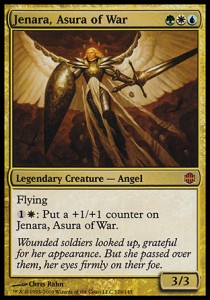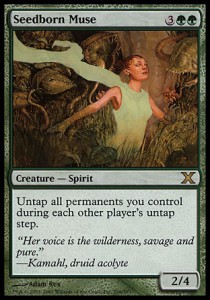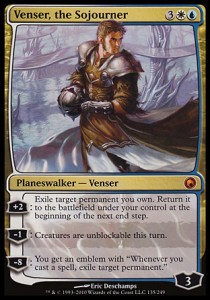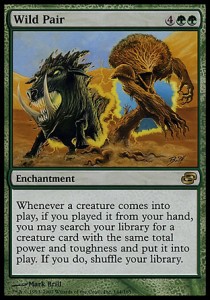Here it is, in all of its terrible glory.
While most of my decks usually elicit a groan when I bring them out at the EDH table, this one tends to get people agreeing amongst themselves ahead of time, “Okay, Coda dies first, alright?” It’s not even because it’s particularly broken or unfair, either – the deck has no infinite combos, none of the cards that tend to get bandied about as ridiculously broken, and it rarely swings with anything more threatening than a 6/6. And yet it is almost unstoppable. It’s a perfect case study in how synergy can be exploited to make a deck that is more than the sum of its parts.
The entire deck is characterized by a laser-like focus on abusing enters-the-battlefield effects. Almost every creature has some sort of ETB ability, and the deck is filled with cards that allow me to blink or bounce those creatures over and over again, netting an enormous amount of progressive card advantage. Repeatedly bouncing creatures is extremely mana-intensive, so the deck also has access to a potent suite of ramp spells and mana doublers. Despite being in blue, there’s a distinct lack of counterspells – this is a deck that likes to tap out every turn. Since most effects in the deck are tied to creatures, it also runs an abundance of creature tutors so it can find the right creature for whatever situation the deck is facing.
Supplementing it’s focus on ETB effects is a great deal of redundancy and recursion. Killing a creature barely fazes it – it has a whole host of ways to reanimate, copy, or return creatures and spells in the graveyard to your hand. Likewise, destroying a bounce outlet isn’t much of a blow, as there are no less than eight cards in the deck capable of bouncing or flickering a creature, and multiple ways to get one in the graveyard back to your hand. Even repeatedly wrathing the board doesn’t accomplish much, since every time a creature is brought back from the ‘yard it generates even more value. In order to truly hurt the deck, you need to exile large swaths of it, either by exiling its graveyard (repeatedly) or using an ability like [card]Oona, Queen of the Fae[/card]’s. Even then, the deck is usually able to apply enough pressure with an absurdly large Jenara alone that it can still keep in the game.
Of course, as resistant as it is to disruption, it’s also vulnerable to aggro. It’s hard to grind out incremental advantages vs a deck that just wants to bash your face in with a zillion hasty tokens. There are three sweepers in the deck, true, but it has precious few ways to find them if they aren’t already in hand or in the graveyard. Furthermore, the deck lacks any way to gain life over the course of a game, which means that cards like [card]Sorin Markov[/card], [card]Magister Sphinx[/card], [card]Repay in Kind[/card], and [card]Heartless Hidetsugu[/card] can really put Jenara back on her heels.
This deck usually wins in one of two ways. The first, and simplest is through titan, elephant, and angel beats. With all the ways the deck has to mess with an opponent’s board, it’s not uncommon for a bunch of 6/6s to get there in a few turns, especially if the opponent in question has already taken some hits from another player. The other win condition usually involves a resolved [card]Genesis Wave[/card] and a board position that provides both a huge amount of mana each turn to dump into Jenara and a way to protect her (say, [card]Glen Elendra Archmage[/card]). It’s a soft lock, essentially, one that lasts just long enough for Jenara to pump up to 21/21 and swing for the win.
All that said, there’s a couple cards in particular that I’d like to point out that truly make this deck explode.
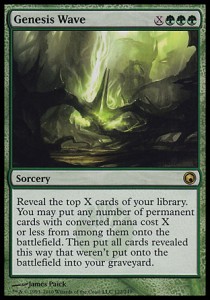
Genesis Wave, you must understand, is simply a different animal than all those other cards out there. No other spell is as effective as vomiting the entire contents of your deck on the board in such a spectacular way. Green mana goes in one end, and then one by one you get titans, lands, angels, artifacts, planeswalkers, and mana doubling enchantments coming out the other. A small Genesis Wave will put you way ahead. A large one will crush your opponents’ hopes and dreams. Recur and chain them back-to-back for even more ridiculousness. Just be on the lookout – there’s nothing a red mage likes more than [card]Fork[/card]ing a wave.
Seedborn Muse does all kinds of format-warpingly hilarious stuff when she gets on the board. With Jenara on the board, you can pump her into 1-hit-kill range pretty quickly. Combined with [card]Teferi, Mage of Zhalfir[/card] and a bounce outlet, she basically gives you one free turn for every one of your opponents’. Games usually don’t last much longer once you start getting some mileage out of her.
Not only is he an incredibly powerful flicker engine, Venser’s ultimate can be absolutly devastating in a deck that can regularly cast multiple spells per turn. [card]Stonecloaker[/card], in particular, is quite evil with Venser’s emblem up – then it essentially reads “2W Exile target permanent and target card in a graveyard. Buyback 0.” His -1 ability doesn’t come up often, but it’s invaluable when an opponent is on the ropes and you just need to force lethal damage through. Bonus points if you use Venser to bounce [card]Venser, Shaper Savant[/card].
One thing you might not have noticed about this deck is that almost all of the creatures’ power and toughness add up to either 4, 6, or 12. That makes Wild Pair extremely powerful. You haven’t lived until you’ve used [card]Admonition Angel[/card] to find [card]Primeval Titan[/card] for free, and then exile a bunch of stuff with the landfall triggers the titan gives you. Bounce Jenara to your hand, then recast her to instantly tutor up her BFF, [card]Seedborn Muse[/card]. You can also pull off shenanigans like casting [card]Venser, Shaper Savant[/card], bouncing their general, then calling up [card]Vendillion Clique[/card] to tuck it at the bottom of their library. Even just calling up a [card]Mnemonic Wall[/card] or [card]Karmic Guide[/card] makes for some pretty insane value.
